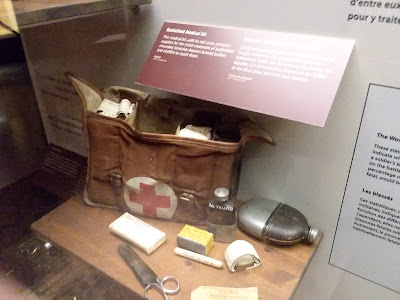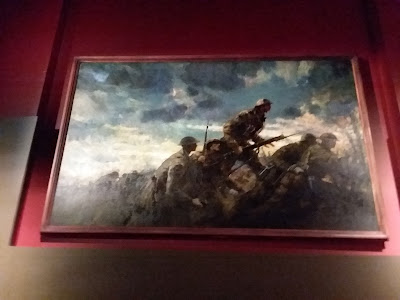Battlefield medical supplies are seen here going back to the time of the First World War.
After four years of generals sending masses of men against opposing positions and modern technology and getting them slaughtered, finally in the last months of the war things changed. The Hundred Days marks the concluding battles of the war, with Allied forces adapting to use combined arms fighting to turn the tide and win the war. Simply put: coordinate all of your military assets on the field and work together- infantry, tanks, artillery, and air. This is what won the war. If only it had been learned earlier.
The senior Canadian general, Arthur Currie, would likely have ascended to command to all British empire forces had the war gone on. As it was, he was one of the best generals in Canadian history, a methodical commander whose efforts helped in bringing his men victories.
This ceremonial sword was presented to him by senior officers after the war out of respect to him.
Thomas Ricketts won the Victoria Cross for extraordinary bravery in battle late in the war.
Lieutenant Samuel Honey won it too for his own courage in battle, though he would not live to see the end of the war.
A uniform jacket and cap, along with regimental colours, is displayed here.
This unusual painting always catches my eye. The living march with their ghostly comrades in this painting titled The Conquerors.
Another painting, one of the most dramatic in the Museum's collection, depicting a moment during the Hundred Days. Over the Top, Neuville-Vitasse shows men of the 22nd Battalion at a village at the front in late August 1918 pushing the attack against the Germans. Georges Vanier, who decades later would be the governor-general of the country, said that he was the officer seen in the painting holding his pistol.
This is the ceremonial headdress of Corporal Francis Pegahmagabow, a sniper who is the most highly decorated Indigenous soldier in Canadian history. After the war he would be a chief of the Ojibwa.













Interesting fragments of history.
ReplyDeleteScary pics.
ReplyDelete17... that´s a kid.
Is today scarier?
My uncle was 15 when he had to be a soldier, was caught by the Russians and spent 10 years in Siberia ! When he came back he was 25 !
ReplyDeleteThe paintings are dramatic, great exhibit!
ReplyDeleteTake care, enjoy your day!
...those hundred days must have seemed like an eternity.
ReplyDeleteI find the paintings incredibly moving -- and beautifully done. If only those fighting had known they only had 100 days to go.
ReplyDeleteThe paintings are indeed beautiful!
ReplyDeleteGood to learn about General Currie. Thank you.
ReplyDeleteThe artists are an amazement to me - that they could create in the midst of all that death.
ReplyDeleteMuch has been written about the failed tactics used over and over again and the waste of troops.
ReplyDeleteWhat a dark period.
ReplyDelete@Italiafinlandia: very much so.
ReplyDelete@Iris: a boy who became a man pretty fast.
@Gattina: brutal.
@Eileen: thanks.
@Tom: they would have.
@Jeanie: after four years of hell.
@Magiceye: they really are.
@Marie: you're welcome.
@RedPat: some closer than others. There was an artist who landed on Juno Beach on D-Day in the midst of the fighting.
@Red: if only the lessons had been learned sooner.
@Jan: that it was.
Amazing art created is such turbulent times.
ReplyDeleteThe Boy Soldier, terrible to be in a war at 17.
ReplyDeleteGreat 'Path to Victory display and photos ~
ReplyDeleteWishing you a happy and healthy day,
A ShutterBug Explores,
aka (A Creative Harbor)
Thank you for sharing these interesting exhibits.
ReplyDeleteThese are dramatic. So much has been invented due to wars, as well as our understanding of PTSD.
ReplyDeleteThe handle on the sword is a work of art.
ReplyDeleteInteresting to see the battlefield medical supplies.
ReplyDeleteI admire all medical personnel involved in wars.
All the best Jan
@Sharon: indeed.
ReplyDelete@Bill: it was.
@Carol: thanks.
@Denise: you're welcome.
@Jennifer: PTSD is awful.
@Gemel: I agree.
@Jan: they had much to do.
Would love to visit there. With homeschooling my kids I have been visiting LOTS of museums recently. Thanks for sharing! <3 - http://www.domesticgeekgirl.com
ReplyDeleteI love museums.
DeleteThat was a terrible loss of young men.
ReplyDeleteIt was.
DeleteThanks for the march through time.
ReplyDeleteYou're welcome.
DeleteWorld War One was very tough on the soldiers of the empire. The Yanks were not thrown in the meat grinder by Pershing.
ReplyDeletePershing was a great general. Tough, methodical, and willing to stand his ground.
DeleteWilliam - war is such a devastating event - so many lives sacrificed. I would not want to be a general or any other level of command that has to make those difficult tactical decisions.
ReplyDeleteTo borrow a quote, to be a good soldier you must love the army. To be a good commander you must be willing to order the death of the thing you love.
Delete